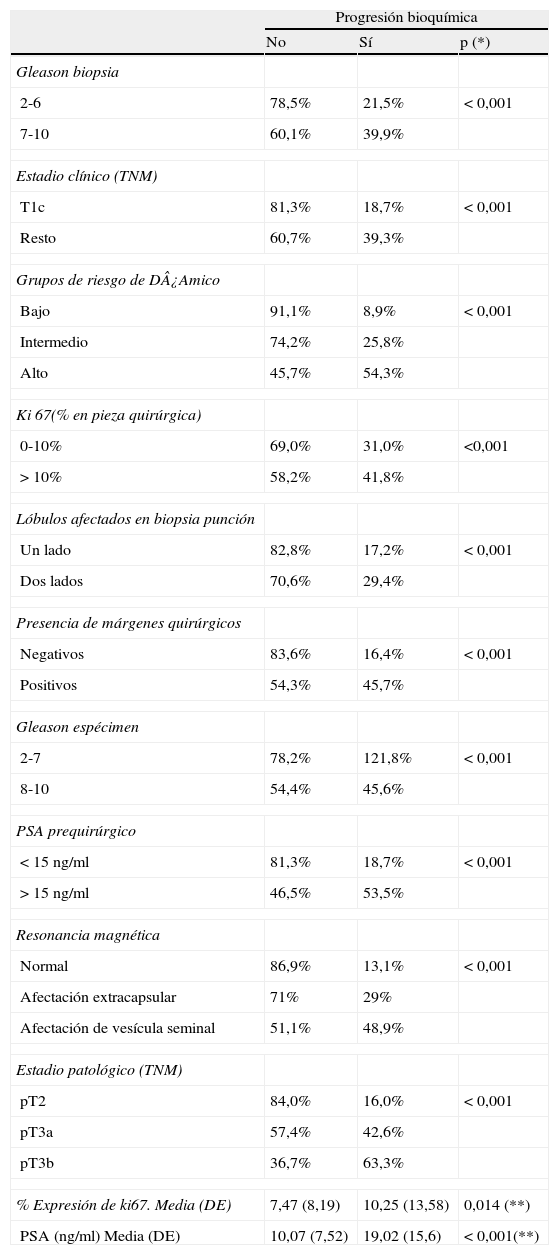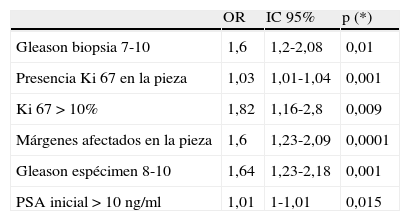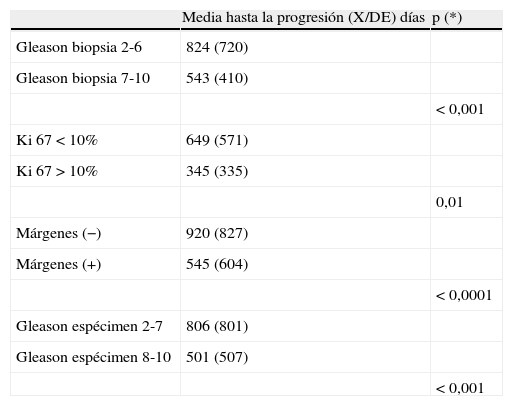Se han evaluado los factores clínico-patológicos influyentes en el tiempo hasta la progresión bioquímica en una serie homogénea de una única institución.
Material y métodosAnálisis retrospectivo de 278 pacientes con progresión bioquímica tras prostatectomía. Se consideró progresión bioquímica PSA > 0,4 ng/ml. Se realizó estudio mediante modelo de Cox (univariado y multivariado) y «t» de Student para comparación de medias.
ResultadosCon una media de seguimiento de 4 años (± 3 DE) el estudio univariado reveló una media hasta la progresión para el score Gleason 2-6 en la biopsia de 824 días y 543 para Gleason 7-10 (p=0,003). Para los márgenes quirúrgicos negativos la media fue 920 días y 545 para los márgenes positivos (p=0,0001). En el caso del score Gleason del espécimen 2-7 la media fue 806 días y 501 para el Gleason 8-10 (p=0,001). Por último, la media para los casos con Ki-67 negativo en el espécimen (< 10%) fue de 649 días y 345 para Ki-67 positivo (> 10%) (p=0,003). En el estudio multivariado Ki-67 (OR 1,028; IC 95% 1-1,01; p=0,0001) y Gleason 8-10 (OR 1,62; IC 95% 1,05-2,45; p=0,026) en el espécimen, y PSA inicial > 10 ng/ml (OR 1,02; IC 95% 1,01-1,04; p=0,0001) fueron variables independientes. Utilizando estas variables se diseña un modelo predictivo con tres grupos. El tiempo hasta la progresión en cada grupo fue de 1.081, 551 y 218 días respectivamente.
ConclusiónEl Gleason 7-10 en la biopsia prostática, la presencia de Ki-67, los márgenes positivos y el Gleason 8-10 en el espécimen y el PSA inicial >10 ng/ml son factores influyentes en el tiempo hasta la progresión bioquímica. Gleason patológico 8-10, PSA > 10 ng/ml y Ki-67 son factores independientes.
We assessed the time-influencing clinical-pathological factors for biochemical progression of an equal series of patients from a single institution.
Materials and methodsRetrospective analysis of 278 patients with biochemical progression following prostatectomy. We considered biochemical progression to be PSA>0.4 ng/ml. We performed the trial using the Cox model (univariate and multivariate) and using the Student's t-test to compare averages.
ResultsWith a mean follow-up of 4 (±3 DE) years, the univariate study showed a mean until progression for the Gleason score 2-6 in the biopsy of 824days and 543 for the Gleason score 7-10 (p=0.003). For negative surgical margins, the mean was 920days and 545 for positive margins (p=0.0001). In the case of a Gleason score 2-7 in the specimen, the mean was 806days and 501 for a Gleason score 8-10 (p=0.001). Lastly, the mean for the cases with Ki-67 negative in the specimen (< 10%) was 649days and 345 for Ki-67 positive (> 10%) (p=0.003). In the multivariate study, Ki-67 (OR 1.028; IC 95% 1-1.01; p=0.0001) and Gleason score 8-10 (OR 1.62; IC 95% 1.5-2.45; p=0.026) in the specimen, and initial PSA >10 ng/ml (OR 1.02; IC 95% 1.01-1.04; p=0.0001) were independent variables. Using these variables, we designed a predictive model with three groups. The time until the progression of each group was 1,081, 551 and 218days respectively.
ConclusionThe Gleason score 7-10 in the prostate biopsy, the presence of Ki-67, the positive margins and the Gleason score 8-10 in the specimen, and the initial PSA > 10 ng/ml are time-influencing factors until biochemical progression. Pathological Gleason score 8-10, PSA > 10 ng/ml and Ki-67 are independent factors.
Artículo
Comprando el artículo el PDF del mismo podrá ser descargado
Precio 19,34 €
Comprar ahora














